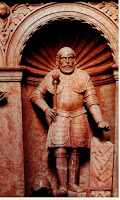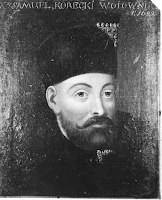Salvete Omens,
back to Chocim campaign -
… young sultan Osman II declared war on Polish-Lithuanian Commonwealth and war preparations entered new phase in the early 1621. But as noted by some chroniclers the Turkish capital elites were much against going to war with Polish realm. Even more than reluctant, they wanted to pay for the already extended costs and expenses towards the 1621 campaign-in-organisation.
Perhaps the Ottoman Turkish elites and even the imperial merchant class were tired of the constant state of warfare the empire had been in since the late XVI century. Polish observers also noted that lackluster will for war against Polish king and his subjects. But it was the sultan who made his will realized, i.e., by undertaking this 'easy war' against the Polish infidels and their Cossack proxies.
So the Sultan willed and thus his Ottoman army concentrated at Adrianopole (Edirne) in Thrace, outside Constantinople, and the force was to march onto Silitsria. First, they had to march to Nikopolis on the Danube. So the army marched across the Balkan mountains to the valley of Danube and north into Transdanubian principalities. They had crossed 450km of rocky roads and upon entering the valley of Danube, its swampy country. It took them almost a month to make this trek.
Then
they marched along the river in Dobrudja Tatar country, very rough and unhealthy season to be in that swampy province, to the river
port town of Galati, in order to cross the Danube in its vicinity.
Artillery was brought there via the Black Sea shipping and landed on
the left bank of the great river. They all came there in July, and
starting July 11 the crossing of the great river begun. The bridge
built in order to have the army cross was under the strain from the
swift currents of the river(about 700 meters wide there), and the
Ottoman navy under Kapudan-Pasha had to fight off the Cossack
flotilla that attempted to break the bridge. The prisoners taken in
this river battle were executed, including murder by pulling them
apart with the elephants. The massacre of these Cossack prisoners was
to keep the spirit of the army high and bellicose. At the same time
other Cossack flotillas attacked Ottoma shipping on the Black Sea,
including fighting large scale battles with the Ottoman navy (one
flotilla under Bohdan Chmielnicki, future hetman of Zaporozhian
Ukraine). While crossing the river, young sultan practiced
archery(his arrows were able to hit targets across the river) and
received news that his Crimean Tatar vassal, khan Djanibeg/Janibeg
Giray, and his 10,000 Tatars crossed the Dniester river and were
encamped awaiting the emperor's host.
On July 18th
the vanguard of Osman’s army marched away from the Danube. On the
28th of July a column of cavalry under Beylerbey Dylewar Pasha from mostly Kurdish Dyarbekir eyalet in the south-eastern of
Anatolia.
On August 16th the vanguard reached old
Polish camp at Cecora. There the entire army rested and mustered
before their final push towards Chocim on the Dniester River and its
Commonwealth defenders.
The army marching from Cecora camp on the Prut River to Chocim battlefield on the Dnieper River was set up as follows:
10,000 cavalry column from Rumelia and Anatolia commanded by Hussein Pasha.
After them, various
units of Wallachian and Moldavian vassals , charged with repair of
roads and building water crossings and managing terrain obstacles.
Next, marched the remainder
of units from Anatolia and the sultan’s Kapikulu janissary corps under Hussein Pasha, the great vizier.
After that ‘division’ marched sultan himself, with his corps of elephants and entire court, with the timariot cavalry and his spahis corps of Kapikulu army.
After the sultan’s
division marched the artillery, and then the entire train of wagons
and camels, and slaughter animals (oxen, cows, goats and sheep) and
spare horse herd.
The entire Ottoman host was screened by the
light cavalry, aware of the Cossacks bands that had been lurking
around in Moldavia since at least August 8. Hetman Borodwaka and his
Cossacks ruined the countryside between Jassy and the Polish border,
thus the Ottoman host marched across the despoiled and pillaged
country, putting strain on their supply lines and comforts.
Crimean Tatars fought the marauding Cossack bands and
larger units, and some of the fights were epic, the most memorable
were two encounter - the defense of some cave near the Prut River
by a small troop of Cossacks against the entire Ottoman army, as the
Tatars were reluctant to storm the cave full of firearms and
determined Cossack fighters; and the second the defense of about 200
Cossacks who dug pits and felled trees on the other side of the Prut,
across from the first fight. They fought the Ottoman might until the
darkness of the night, and then tried to make their escape. Only few
made it alive to the Polish side. But these and other fights delayed
Ottoman progress and caused waste to the country where the Ottomans
could have relied on getting supplies.(story of hetmans Borodawka and
Konaszewicz_Sahajdaczny conflict and murder during the August march
will be for anther time).
Finally, on September 2nd,
1621 about 3-4 miles from the Chocim Polish camp the vanguard of the
Ottoman forces was sighted.
Thus Osman II reached Chocim and
his army begun building their widely spaced camps and constructing
gun posts for their artillery, while he witnessed his chosen janissaries attack the Cossack camp.
The counting of numbers for this army could present a problem – already, in 1621 contemporary Polish sources noted the following accounting of Osman’s troops:
30,000 Spahis/sipahi,
20,000 Janissaries
60,000 Tatars (Crimeand and Budjak Nogai etc)
100,000 timariot troops and other troops. - in total: 201,000 soldiers [sci!].
Jan Wimmer (1061),
modern historian, cestiamted 100,000 Ottoman soldiers, including
15,000 Tatars.
Jerzy Teodroczyk(1984), another modern historian,
estimated 110,000 soldiers.
XVII century historians – French Ricaut and Turkish Ayna Ali- provided more precise description, and Polish historian Leszek Podhorodecki put down the following list fore the kapikulu, timariot, volunteers, vassals, artillery etc:
-Beylerbey of Anatolia Hassan Pasha – circa 14,000 (max 25,000)
-Beylerbey of Rumelia Jusuf Pasha – 18,000 (max, 22,000)
-Tayjar Bey Pasha of Aleppo sanjak – 2,000 (max 3,000)
-Beylerbey of Diarbekir Dylewar Pasha - 4,000 (max 10,000)
-Beylerbey of Bosnia Hussein Pasza – 7,000 (mac 14,000)
-sanjak of Tripoli – over 1,000
-Beylerbey of Syvash Ibansagly Hassan Pasha – 3,000 (6,000 max)
-Beylerbey of Karaman Mustapha Pasha – 2,000 (3,000 max)
-Sanjak of Marash under Abazy Pasha – 1,000
-Beylerbey of Damascus Nogai Pasha – 2,500 (5,000 max)
-Beylerbey of Caffa Cherkess Hussein Pasha – 2,500 (5,000 max)
-sanjak of Raqqa – 2,000
-volunteers from Dobrudja – 1,000
-various Ottoman officials’ retinues and nomadic vassals – 5,000
finally, Beylerbey of Buda Karakash Pasha – 5,000 (10,00 max) – that came to the sultan’s camp after the siege battle had already started.
So perhaps 55-60,000 to 70,000 – after all the losses from sickness, marching or even desertion.
Next the Kapikulu sultan corps–
8,000 spahis/sipahi corps
12,000 jannisary corps – commanded by Aga Mehmed Pasha
(a part of the kapikulu corps stayed behind, guarding crossings . And actually deserted during the march)
The artillery consisted of at least 62 guns, including 15 heavy ones (up to 55 punders) – managed by perhaps a less than a thousand soldiers and assistants.
The vassal
Tatars – according to Olgierd Gorka, Polish modern historian, -
10,000 Crimean Tatars under the khan, 5,000 Budjak and Dobrudja
Tatars under Kantemir Murza; and 1,000 Tatars of the Sultan guard.
Wallachains – under prinece Radu Minchea 6,000 to 7,000
Moldavians – unde Stefan Tomza circa 5,000.
Finally, all these
soldiers were provided for and were supplemented by the unknown
number of armed and unarmed camp servants and followers – perhaps
as many as 50,- 60,000 thousand men?
Plus thousands of pack
camels, horses, draft oxen, cows, sheep and goats, and probably
thousands of wagons and carts.
…
Perhaps it is worth noting that during the first large engagement, the janisaries attack on the Cossacks camp on September 2, 1621, the first Polish-Lithuanian officers killed during this hot fight were two Muslim Lithuanian Tatars - captain Bohdan from Zenowicz’ pulk and captain Czarowicz from the grand hetman’s pulk – these two captains or rotameister died fighting bravely and heroically in the defense of their king and country.
.
valete
ps
all image from Wiki Commons





























